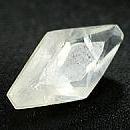|
|
||||||||||||||||
|
||||||||||||||||
|
||||||
|
|
|
|
Tincalconite
|
|
| | |
| Discovered in 1878; IMA status: Valid (pre-IMA; Grandfathered) | ||
|
| ||
|
Chemistry |
|
|
| |
|
Na2(B4O7) • 5(H2O) | |
|
|
Hydrated Sodium Borate |
|
Molecular Weight: |
855.86 gm |
|
Composition: |
Sodium |
16.12 % |
Na |
21.73 % |
Na2O |
|
|
Boron |
15.16 % |
B |
48.81 % |
B2O3 |
|
|
Hydrogen |
3.30 % |
H |
29.47 % |
H2O |
|
|
Oxygen |
65.43 % |
O |
|
|
|
|
|
100.00 % |
|
100.00 % |
= TOTAL OXIDE |
|
|
|
||||
|
Classification |
|
|
| |
|
BORATES | |
|
5/H.10-20 | |
|
|
6 : BORATES
|
|
Related to: |
Tincalconite-Borax Group. |
|
Members of Group: |
Tincalconite-Borax Group: Borax, Tincalconite |
|
Varieties: |
None |
|
Synonyms: |
Mohavite, Octahedral Borax, ICSD 66529, PDF 7-277 |
|
|
|
|
Crystal Data |
|
|
|
|
|
Rare crystals are pseudo-octahedral, exhibiting {1011}, {0112}, and {0001}, to 1 cm; commonly as a powder. Cryptocrystalline - occurs as crystals too small to distinguish with the naked eye. |
|
|
None |
|
|
|
|
|
Physical Properties |
|
|
|
|
|
Indistinct on {001} |
|
|
Hackly |
|
|
Brittle |
|
|
2.0 |
|
|
1.88 (g/cm3) |
|
|
White under both SW and LW |
|
|
Not Radioactive |
|
|
|
|
|
Optical Properties |
|
|
|
|
|
Colorless to white; colorless in transmitted light |
|
|
Transparent to translucent |
|
|
Vitreous to dull |
|
|
1.461 - 1.474 Uniaxial ( + ) |
|
|
0.013 |
|
|
n/a |
|
|
None |
|
|
|
|
|
Occurances |
|
|
|
|
|
Geological Setting: |
Metamorphosed bedded borate deposit in clay-shales. Typically a dehydration product of other borates. |
|
Common Associations: |
Borax, Kernite |
|
Common Impurities: |
n/a |
|
Type Locality: |
Searles Lake, San Bernardino County, California, USA |
|
Year Discovered: |
1878 |
|
View mineral photos: | |
|
|
|
|
More Information |
|
|
|
|
|
| |
|
|
|
|
In addition to several California and Nevada locations it is reported from Argentina, Italy, Turkey and Ukraine. Tincalconite is named from the Sanskrit word tincal for borax, plus the Greek word konis, meaning powder, in allusion to its composition and typical powdery nature. Locations
for Tincalconite: Probably more widespread than the
few recorded localities suggest. In the USA, from the
Kramer borate deposit, Boron, Kern County. and as crystals
at Searles Lake, San Bernardino County, California.
From the Tincalayu borax deposit, Salar del Hombre Muerto,
Salta Province, Argentina. In the Kirka borate deposit,
Eskiçehir Province, Turkey. At Larderello, Val
di Cecina, Tuscany, Italy. From mud volcanoes, Kerch
Peninsula, Ukraine. |
|
|
We
have not photographed our Tincalconite
gems. Please
check back soon. |
